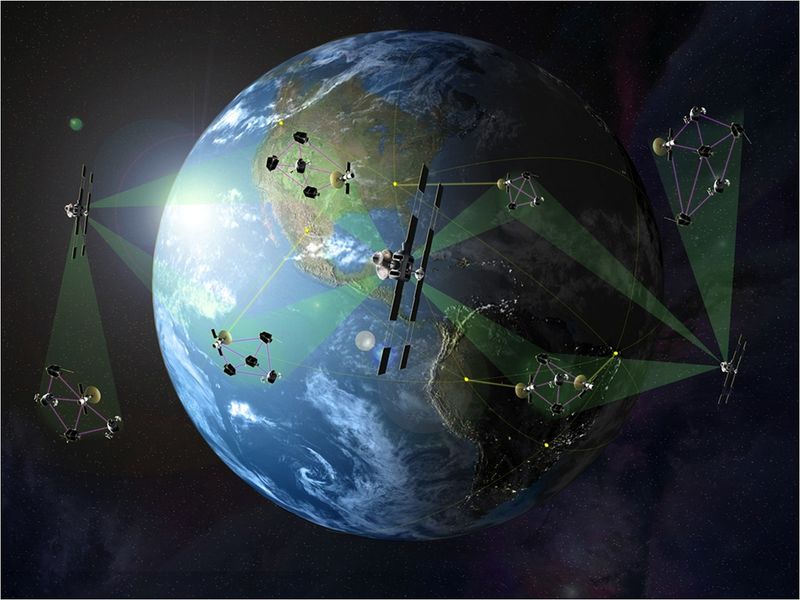What’s the Difference Between LEO, MEO and GEO Satellites?

As of the beginning of 2023, nearly 15,000 satellites are orbiting our planet — more, since SpaceX just launched the first rocket of the year with 114 satellites in one monumental event. With so many orbiting bodies circling the Earth, it’s a miracle they don’t crash into each other, right?
It might seem like magic, but in reality, it’s because they aren’t all orbiting at the same height. Let’s take a closer look at what LEO, MEO and GEO satellites are, and why more companies are investing in LEO and MEO satellites to support space exploration.
What’s the Difference Between LEO, MEO, and GEO?
The difference between them is that low Earth orbit (LEO) includes everything up to 2,000 km above the surface, geostationary orbit (GEO) is at 35,786 km above the equator where satellites appear fixed in the sky, and medium Earth orbit (MEO) is everything in between.
LEO — Low Earth Orbit
Satellites in low Earth orbit, or LEO, are the closest devices to Earth. They’re only up to 2,000 km above the Earth’s surface, or about one third of the radius of the Earth, making them ideal for satellite phone and GPS communication. The relatively small distance means there is a minimal delay between the data leaving the satellite and it reaching its target on Earth — usually about 0.05 seconds.
It takes a lot of LEO satellites to cover the planet, which is why there are so many of them up there. The Iridium Communications Network will consist of 66 satellites total, while the Starlink constellation will include nearly 12,000 satellites once they’ve all launched, though they won’t all be in LEO.
The International Space Station is also in low Earth orbit.
MEO — Medium Earth Orbit
Medium Earth orbit, or MEO, satellites are a bit of a middle ground between LEO and GEO orbits, circling the planet at altitudes between 2,000 and 35,786 km. These satellites handle high-speed telephone signals and may, in the future, find a place in the military sector as a tool to provide low-latency high-bandwidth internet to military personnel around the globe.
In spite of a slightly higher signal lag of about 0.1 seconds, depending on the size of the antenna, these MEO satellites can transmit data as quickly as 1.6 gigabits per second. For comparison, the fastest readily available commercial internet, not counting Google Fiber cities, is usually around 100 MB/s — less than a tenth of the speed these MEO satellites will be capable of providing.
As these devices move further out into the cold of space, they need more tools to protect the sensitive computer equipment that makes them work. Heat pipes have two purposes — they can transport heat away from the electronics to prevent them from overheating, and they can redirect that heat to different parts of the satellite to prevent them from freezing.
GEO/GSO — Geosynchronous Equatorial and Geostationary Orbits
You’ll often hear the terms GEO and GSO used interchangeably, but they’re not always the same. Both types of satellites sit at 35,786 km above Earth’s surface, but the way they orbit is different. Both orbits synchronize with the orbit of the planet, so they appear in the same place every day.
The difference between GEO and GSO is that GEO satellites orbit on an angle between the planet’s poles, while GSO satellites carry out the same high-altitude circular orbit around the Earth’s equator.
Both GEO and GSO satellites carry satellite television signals. GSOs can also forecast the weather and support other types of global communication. It only takes three GEO or GSO satellites to cover the entire planet because of their altitude. If you’re accessing satellite TV or radio, you don’t have to use the antenna to track the satellite because it’s always going to be in the same place.
Satellites and Space Exploration
Satellites used to be a “last resort” for communicating with remote areas, but today they’re a vital tool to support global information exchange. Eventually, they may even allow us to communicate quickly and easily between bases and colonies on the Moon, Mars and beyond.
SpaceX, OneWeb and even Facebook are working on designing satellite constellations that will provide affordable consumer internet to the entire planet. SpaceX got the ball rolling with the launch of the first 60 satellites of their Starlink constellation. Eventually, these communication satellites will sit in all three orbits, providing fast and affordable internet to anyone with a compatible device.
Looking Toward the Future
The future of human communications, both at home and in outer space, lies in the stars — or, rather, in the constellation of satellites orbiting our planet. We don’t have colonies on our closest celestial neighbors — yet — but we’re well on our way to becoming the interstellar species all the science fiction readers and writers have been dreaming about for decades.
Originally published on Jun 1, 2019 by Megan Ray Nichols. Last updated on July 28, 2023 by Paul Tomaszewski.
Would you like to receive similar articles by email?





